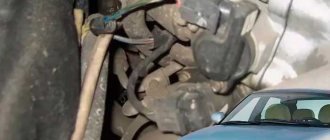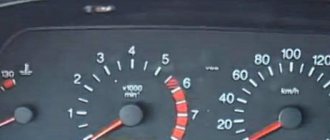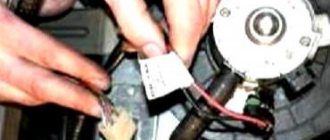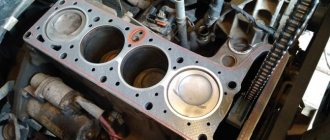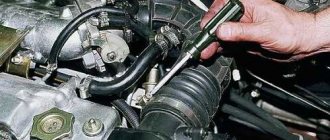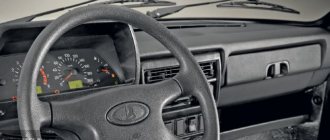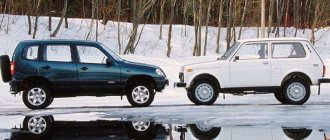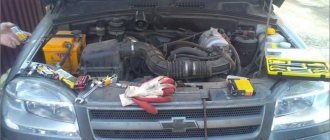In commonly used terminology, there is always an error in the name of this device, which sets the engine speed when the gas is released, that is, when the throttle valve is completely closed. It is called a sensor, although, of course, it is not a sensor at all. The Chevrolet Niva idle speed control (IAC), as on all other cars, is an actuator in its principle of operation.
Let's consider the reasons for the appearance of this device in the injection control system, the principle of its operation, characteristic signs of malfunctions and methods for finding them. A driver who understands this will be able to independently fix a significant part of the problems in the power system.
Troubleshooting electrical wiring
So, if the actions described above do not bring results, you need to start troubleshooting and directly repairing the electrical wiring.
Troubleshooting involves dividing all electrical wiring into separate sections. To know how electrical wiring is divided into sections, it is advisable to have a wiring diagram on hand.
A small example of electrical wiring repair in a private house
Initial data: Let's say the sockets and lighting in the kitchen and bedroom do not work.
Cause of malfunction: Wire-2 is damaged (but we don’t know about it yet).
We will divide the electrical wiring repair into several stages. First, you need to check the power in distribution box No. 2, since it is from it that the kitchen and bedroom are powered.
Let's open this box and take a look. The connection points of the wires must be intact, not torn (burnt off in case of a short circuit) and in good condition (without melting of the wire insulation). If necessary, we press the twisted wires for better contact (if twisting was used to connect the wires).
If there is no visible damage in the box, after inspection we check for the presence of voltage at the junction (twisted) of wires 1 and 2 (box No. 2). There must be tension! If it is not there, then the problem is poor contact.
Let's move on, now we need to check whether voltage is coming to junction box No. 3. To do this, open it and also use a pointer to check the presence of voltage on the conductors of the wire. No tension! This means the problem is in the wire (for example, it was damaged by an electric drill when installing the picture).
To finally make sure that the wire is damaged, you need to check its integrity. To do this, we turn off the machine at the entrance to the house, unscrew wire 2 on both sides (in the distribution box No. 2 and No. 3) and use a “dialer” to check the wire strands for integrity.
In this case, there are three ways to solve the problem with a damaged section of wire:
- . Remove the damaged wire and install a new one in the wall instead. To do this, you need to trench a section of the wall with a damaged wire;
- . Lay a new one over the damaged wire in an open way in the cable channel (open wiring).
- . If, when installing electrical wiring, a three-core wire was initially laid, and there is no grounding in the house, then you can use the third core as a working one (this is provided that one of the cores in the non-working wire is damaged).
If there is no electricity in the entire house, then first of all the presence of voltage is checked at the input circuit breaker. If the circuit breaker is working properly, the voltage will be both at the input and output of the circuit breaker (of course, in the on position of the latter), and then proceed according to the above diagram.
Electrical wiring repair tool
The main tools for repairing electrical wiring are:
- - voltage indicator or multimeter to check voltage;
- - pliers with insulating handles - for twisting wires in the junction box;
- — a screwdriver in case the terminal clamps of protective devices (automatic machines, RCDs, etc.) are unscrewed or tightened;
- - PVC insulating tape - for insulating exposed parts of the wire after twisting.
There is another irreplaceable parting that every electrician should have - a “diagnosis”. This device consists of a regular battery, a light bulb, connecting wires and clamps. All these elements are connected in series to each other. Making it is not particularly difficult.
Using a “continuity test” you can easily check the wires for integrity. Especially with hidden electrical wiring.
Why don't the revs drop?
There are quite a lot of reasons for the appearance of such an unpleasant phenomenon, let's try to understand this issue together and decide how to get out of this situation. Most often, in injection engines, speed reduction does not occur due to the fault of the throttle assembly, in which contamination occurs. Old engines, worn out by time, most often suffer from this. Engine oil is released into the power system, it burns in the intake tract and prevents the damper from moving into place. Because of this, an unauthorized supply of the fuel mixture to the engine cylinders occurs, which leads to an increase in idle speed.
Fuel supply
It is very easy to understand that the reason that the car stalls due to choking of the fuel mixture is that if you drive for a long time, the signal that is responsible for this function will begin to constantly turn on. This problem is associated with low quality fuel, since the spark from the candles is not enough to quickly ignite it. Another reason that the Chevrolet Niva stalls may be:
- Dirt in the fuel filter
- Injector nozzles are faulty
- Dirty throttle valve
There are minor interruptions in the power supply to the fuel pump
The presence of these problems leads to the fact that the engine power decreases and it begins to stall.
Engine temperature sensor
If the device breaks down, the dashboard provides incorrect data regarding the engine temperature. To check and change the temperature sensor, proceed according to the following algorithm:
- Prepare an autothermometer for working with high temperatures, a tester and a metal basin with water for heating on the stove.
- Disconnect the connectors and, substituting the basin, remove the sensor from the socket. A plug is placed in place of the sensor.
- The device is placed in cold water with the side screwed into the cylinder head. Measure the resistance and put the basin on the gas.
- Measurements are taken several times at different temperatures and compared with the standard data in the service book.
Significant discrepancies indicate the need to replace the temperature sensor with a new one.
Source
Hot engine stalls at idle speed Niva Chevrolet
Self-diagnosis Niva Chevrolet, replacing the idle speed sensor
The engine does not hold idle speed well or stalls. The injector
idle speed disappears. stalls at traffic lights. in neutral. cause found
The engine of a fuel-injected VAZ car stalls
High, low, engine speeds fluctuate. Mass air flow sensor, DBP+DTV, Air leak. Troubles the engine 2h
Engine IAC. It stalls when you let off the gas and has trouble starting.
Does your car stall when braking? 5 most common reasons!
Troit shniva on xx
FOUND!!! Chevrolet Niva
Engine Troit! It stalls! Carburetor, Injector. How to check VUT. Vacuum brake booster for internal combustion engines
Also see:
- Fuel level sensor Niva Chevrolet change video
- Installing a deflector on the hood of a Chevrolet Cruze
- Novi Lexus 570 2016
- Engine oil for Mitsubishi Colt
- Side window deflectors Mazda 3 sedan
- Mercedes Benz f 015 release date
- Where is the BMW 525 battery located?
- Nissan bluebird sylphy 2000 body
- Evap error p0441 on Lexus
- Wheel sizes for Skoda eti
- What type of body does the Chevrolet Niva have?
- Automatic transmission oil Subaru Forester 2011
- Which is better Ford mustang or nissan gtr
- Chevrolet Niva instrument cluster fuse
- KAMAZ Bosch fuel pressure regulator
Home » Best » Hot engine stalls at idle Niva Chevrolet logovaz-auto.ru
A few more words about over-revving
If servicing the above components does not lead to the restoration of idle speed, you should pay attention to another component, which is the electronic control unit, which drivers call among themselves “brains”. Problems in its operation in many cases lead to such failures. If this is the case, then the ECU is simply replaced with a new unit.
To prevent this from happening to your car, follow the deadlines and carry out proper maintenance of the car and its systems. Use high-quality operating fluids, then you will not have a question about why the engine speed on the Chevrolet Niva does not reset. We hope that if such a malfunction occurs, the article will help in resolving it.
Replacing the idle speed sensor on a Chevrolet Niva
Self-diagnosis Niva Chevrolet, replacing idle speed sensor
The engine does not hold idle speed well or stalls. The injector
High, low, engine speeds fluctuate. DMRV, DADDTV, Air leak. Troubles the engine 2h
The Niva Chevrolet has lost idle speed. The coolant temperature sensor is faulty.
Strange behavior of Niva. We diagnose the internal combustion engine.
The engine of a fuel-injected VAZ car stalls
idle speed disappears. stalls at traffic lights. in neutral. cause found
Stalls when cold. Injection engine. No singles
A frequent type of breakdown of a car, especially ours (VAZ cars), is when the car stalls at idle. It manifests itself like this: - we started the car, we accelerate, everything is fine, we just take the pedal off the gas, the speed starts to float, the engine detonates (jerks). That is, the engine speed fluctuates from 100 to 1000, although the tachometer needle should be at the 1000 revolution mark. After a while the car stalls. If we start it, then it all repeats. What to do? Let's figure it out......
idle speed disappears. stalls at traffic lights. in neutral. cause found
I will list the reasons why the car does not idle.
1) The first reason, and perhaps the most likely, is the idle speed sensor. It is this sensor that is designed to keep the car idling while starting the engine. It is very easy to check, if the car does not start, that is, the starter turns the engine, but the car does not start, then try to press the gas pedal a little, the car should start. But if you take your foot off the gas pedal, the revolutions will begin to “float”, then the car will stall. Such symptoms are typical for the idle speed sensor. We just change it, on our VAZ it changes in five minutes.
2) Perhaps the car’s throttle valve is simply clogged. The idle speed of the engine will fluctuate, and the car may also stall. Just need to clean the throttle body. You can read how to clean the throttle valve on FORD cars.
3) If cleaning the throttle valve does not help, then your throttle position sensor (TPS) may be broken. We change it only after we have cleaned the throttle valve itself. It is located next to the idle speed sensor and can also be changed in five minutes.
READ How to check the camshaft sensor Niva Chevrolet
These are, in principle, all the reasons that affect the operation of a car engine at idle. If you have a VAZ car, then replace both sensors at once, the idle speed sensor and the throttle position sensor, but do this after cleaning the valve itself. The problem that the car stalls at idle should disappear.
Fuel jet
It should be checked when the car stalls at idle. To check, you need to turn on the ignition and reset the wire from the EMC and reconnect it. A click should be heard. When it is not there, you should check whether voltage is supplied to it. In some cases, you will have to completely replace the part.
Self-diagnosis Niva Chevrolet, replacing idle speed sensor
The carburetor is Niva’s problem
Troubleshooting Methods
You can solve problems with jumps and floating speeds yourself:
- To confirm and eliminate the possibility of air leaks from the outside, check the supply system for leaks. Using a compressor or pump, supply air to the removed hose placed in water. This allows cracks to be detected.
- The resistance of the IAC is measured. Values within 40-80 Ohms indicate that the device is not working.
- During the diagnostic process, the crankcase gas ventilation valve is cleaned. It is removed and washed with kerosene or carburetor cleaner.
- When sensors fail, they are not repaired, but replaced immediately.
- If the throttle valve requires washing and removal, it is recommended to entrust the job to a specialist. Without removing the damper, you can wash the part yourself using a cleaning aerosol.
- Adjust the idle speed by setting the “quantity” and “quality” screws on the carburetor. Clean the nozzle with an aerosol and blow it out with compressed air.
In most cases, eliminating these causes helps to get rid of floating speed.
Floating speed: reasons
Note that in some cases the revolutions do not just slowly fall or remain at the same level, but “float”. In this case, the engine may become unstable. Floating speeds first fall, then increase sharply and everything repeats. A common cause of this phenomenon is the supply of excess air, which leads to “jumps” in speed at idle.
Such problems arise if the air supply sensor (MAF) fails, which allows the ECU to calculate how much air is supplied and how much fuel is supplied to prepare the required mixture.
If malfunctions occur, the control unit cannot prepare the “correct” mixture for the idle mode, which causes speed jumps after releasing the gas pedal or when the engine is idling.
Operating principle of the idle speed sensor.
The idle speed sensor, otherwise known as the regulator (IAC), allows you to select the optimal crankshaft speed depending on the specified conditions. If this part breaks down, the rhythm of the engine’s operation is disrupted, since a sufficient amount of air does not enter the combustion chamber, or a too lean mixture is formed, as a result of which the engine speed begins to float, this is especially noticeable at idle speed.
The principle of operation is as follows: the air mixture flow sensor (MAF) determines how much air has entered the combustion chamber, after which the electronics calculates how much fuel needs to be supplied to the injectors. The engine speed is read by the crankshaft sensor (CPS), and if this indicator is low, the IAC increases the air supply, simulating pressing the gas pedal. The system operates in the same way when starting from a cold state. The IAC increases the air supply so that the engine quickly warms up to the optimal temperature, or you can start driving without fear of stalling.
Procedure for removing the device.
To remove this device, you need to stock up on a small set of tools, consisting of a 13mm socket wrench, a screwdriver and pliers.
- Place the vehicle on a flat surface and secure it with the parking brake. If there is any doubt about the stability of the car, you need to install wheel chocks.
- After this, you need to disconnect the battery terminals.
- We unscrew the fastening nuts and studs that secure the receiver to the throttle valve. In this case, there is no need to disconnect the pipes of the cooling and crankcase ventilation system.
- Disconnect the terminals from the wires
- Using a Phillips screwdriver, unscrew the valves on the throttle valve
- When the device mount is unscrewed, you can remove it from its seat. Usually, you can get the O-ring along with it. But, in some cases, it may get stuck in the damper well.
- In this case, it is necessary to carefully dismantle it.
But sometimes the device may be working properly, but problems in operation are associated with its clogging. In this case, you can try cleaning it with carburetor cleaner. Typically, this method helps to revive a device that has no visible mechanical damage. But this measure does not guarantee a 100% result, but is only temporary, which allows you to get to the nearest service station or store with spare parts.
The idle speed of the Chevrolet Niva may be incorrectly adjusted if the sensor has increased travel between the valve and the supporting surface. When measured with a caliper, this distance should not exceed 23 millimeters.
Compliance with these parameters is necessary in order to ensure correct installation and not damage the throttle body.
Before installation, the seat must be cleaned. You can also lubricate the O-ring with engine oil to make it easier to put it in place.
Throttle sensor.
The Niva Chevrolet throttle sensor can also affect the smooth operation of the engine at idle. This component controls the amount of air mixture that enters the cylinders. The main task of this part is to make this quantity optimal for high-quality ignition.
The Chevrolet Niva throttle valve is regulated by a special sensor, which, if necessary, closes it, forming a vacuum in the intake system, or opens it, allowing the air mixture to pass through.
If the TPS is faulty, then malfunctions occur during idling. In this case, you need to remove the element and carry out diagnostics.
1. First you need to disconnect the wire block to de-energize the sensor
2. To check its functionality, you need to use a multimeter to measure the voltage between the first and third connectors in the block. In this case, you need to move the damper position from closed to open.
3. The element itself is secured with 2 screws, which need to be unscrewed for replacement.
4. After removing the element, check whether there is an o-ring left in the seat. You need to check its appearance and if everything is in order, install it in place.
5. Now you can install the new part and reassemble in reverse order.
Reasons for unstable engine idling Niva Chevrolet
Poor engine performance 2123
When replacing spark plugs with new ones, install spark plugs with the same characteristics.
Accurate thermal value for engine and operating conditions.
Popping noises from the exhaust pipe at regular intervals indicate that one cylinder is not working due to a failed spark plug, lack of a spark, an injector failure, a strong air leak into one cylinder or a significant decrease in compression. Now he's fine:
If the compression readings are more than one MPa, this is considered normal; if the reading is more than zero one MPa in one of the cylinders, then the engine needs to be repaired.
Top 7 reasons why the engine stalls, and what to do if it stalls? Simple verification methods
https://youtube.com/watch?v=ephtWvjupAo
If the interruptions continue, you should try dousing the outer hose with WD type liquid. Condition of the spark plugs The color of the spark plug may indicate a particular problem. If it has a yellowish-grayish color, this is considered normal, which means that the conditions under which they operate are satisfactory. Dry soot deposits on the spark plugs indicate late ignition, and that there is a rich fuel-air mixture.
If the candle is black and wet, you can throw it away. If all the spark plugs look good, reinstall them and connect the high-voltage wires.
The operating order of the cylinders is 1-3-4-2, the numbering of cylinders 1, 2, 3, 4 is done from the engine crankshaft pulley. Secure it to the engine in any way. Connect the high-voltage wire from cylinder 1 to the spare spark plug.
If engine interruptions do not worsen, replace the spark plug in cylinder 1 with a known good one. Attach the high voltage wire and start the engine.
Interruptions in the operation of the Chevrolet Niva engine
If the interruptions intensify, repeat procedure sequentially. If, as a result of the measures taken, engine interruptions are not eliminated, contact a car service to diagnose the ignition system on a stand or diagnose the engine - measure the compression.
If interruptions in engine operation have stopped, diagnostics and replacement of the vacuum brake booster is required, see. If interruptions in engine operation continue, try pouring WD-type fluid onto the outside of the hose.
3.4 Interruptions in engine operation
If engine interruptions stop even for a short period of time, try replacing the hose - there may be a rupture in it. Brown or grayish-yellowish color and slight wear on the electrodes.
The gap between the spark plug electrodes should be 0.8-0.9 mm. If the candle is black and wet, you can throw it away.
If all the spark plugs look good, reinstall them and connect the high-voltage wires. The operating order of the cylinders is 1-3-4-2, the numbering of cylinders 1, 2, 3, 4 is done from the engine crankshaft pulley.
Secure it to the engine in any way.
Do not fix the spark plug on the oil filler neck, oil dipstick, or fuel hoses. During diagnostics with the MT-4 motor tester, in both cases I saw that the SOP ranged from 6 to 21 degrees.
Fuel rail
On the ramp next to regulator 5 there is a control fitting 3
It is closed with a cap, which is unscrewed, and then carefully pressed on the spool
If fuel flows, it means it is entering the ramp. But perhaps the necessary pressure is not created. Reasons: clogged filter cylinder, pump malfunction, etc.
If fuel does not flow, notice whether the pump turns on when the key is turned to the “I” mark. When the ignition is turned on “cold”, the pump should run for 10 seconds.
Additional mounting block
Know that fuse F2 and relay P4 are responsible for turning on the pump. There is also a main relay P5, and all these elements are located in a block mounted on the same bracket with the ECM (see photo).
Case from practice
What happens if water gets into gasoline? In the summer - nothing. And in winter, the power supply system can become clogged with ice. All elements are at risk, from the pump to the injector valves!
Fuel supply line filter
A small amount of water is always present in fuel. If this number is increased, this is what happens:
- The first start always goes without problems;
- Then, after leaving the car in the parking lot, after 2-3 hours the owner will no longer be able to start the engine without repairs.
All of the above applies to any injection internal combustion engine, including the VAZ-2123. And the “first candidate for failure” will be the fuel filter. It is located under the bottom of the Chevrolet Niva and is encased in aluminum (see photo). However, this is done on many cars.
Pumping up excess air
One smart book says that the engine may not start due to the fact that the intake manifold draws in too much air. This means you need to check the fastening of all pipes. But not only.
Vacuum brake booster
The source of “excess air” may be a faulty VUT. The starter turns, the engine on the Chevrolet Niva does not start, and the reason, it turns out, must be sought in the brake system!
We won't look for anything. Let's do it simpler:
- The vacuum supply hose is removed from the amplifier side (see drawing);
- The hole in the hose is closed with a finger and one test run is performed;
- The engine starts, which means the cause has been found.
That's the whole trick. We wish you success!
Source
View topic
On a working engine control system it is equal to 7 degrees. Now we need to understand what leads to changes in SOP?
In the first case, there was an air leak, which I discovered using a Leak Check fog machine. Malfunctions along the way Updated It is necessary to find the malfunction and, if possible, eliminate it.
Start the engine and let it idle. Go to the exhaust pipe and listen to the sound of the exhaust.
You can bring your hand to the cut of the exhaust pipe - this way the interruptions are felt better.
Diagnostics of DXX
Often, problems with the idle air control valve are confused with a breakdown of the throttle position sensor. A distinctive feature is that the “Check Engine” indicator on the dashboard lights up in the event of a failure of the throttle position sensor.
The following signs indicate a breakdown of the idle air regulator:
- strongly floating speed when starting the car;
- when the heater and headlights are turned on, the revolutions drop below 500 per minute;
- If the car has not been driven for a long time when the ignition is turned on, the engine runs at low speeds without warming up.
If at least one point matches, it is necessary to check the DXX.
To check the functionality, measure the voltage supplied to the regulator:
- The Chevrolet Niva is placed on a level surface and the parking brake is raised.
- The terminals are removed from the IAC.
- Using a multimeter, connect the connectors alternately.
- Turn on the ignition and look at the tester values.
- Normal voltage is considered to be 12 W. Indicators less than 12 indicate a low battery.
- If there is no voltage, check all wiring for an open circuit.
- Test the resistance at the IAC outputs one by one. In good condition it shows 53 ohms.
If the regulator fails, then it is replaced with a new one:
- the car is put on the handbrake;
- remove the negative terminal from the battery;
- unscrew the nuts from the throttle studs without disconnecting the pipes;
- remove the terminals from the idle speed regulator;
- unscrew the screws securing the car sensor;
- take out the device.
The new device is assembled in the reverse order.
Chevrolet Niva starts and stalls when cold, what should I do?
Perhaps the reason should be looked under the hood?
After a long period of parking, the engine starts, runs for a few seconds, and then stalls. There may be several reasons for such a malfunction, but let’s imagine that the diagnostic station is 300 km away from us, and we need to find the cause. We proceed as follows.
Looking at the candles
When using spark plugs with cracks, current leaks through the insulator to the spark plug body.
We unscrew the spark plugs and assess their condition.
If the spark plugs are flooded or wet, then there is a possibility that the idle speed sensor did not turn on, the throttle unit sent the wrong signal to the ECU, which in turn sent too much fuel through the injectors.
In addition, a common culprit for a malfunction with such symptoms is the throttle position sensor. With a high degree of probability, the spark plugs could fail.
Listening to the fuel pump
Niva Chevrolet fuel pump under the seat.
Turn on the ignition and listen to see if the fuel pump is working.
There is a possibility that fuel is not supplied to the ramp, and the engine flared only due to the remaining gasoline in the fuel line.
If this version is confirmed, then the engine will no longer start, the fuel pump needs to be repaired, the fine filter or mesh, or the coarse filter on the fuel pump itself must be replaced.
Looking for an air leak
You should look for air leaks under the hood.
Air leaks in the power system can also cause a similar malfunction. A mixture that is too lean at startup will prevent the engine from running after a flash.
To verify this in field or garage conditions, just cover the air intake pipe of the air filter.
Often, air leaks can occur between the filter housing and the throttle assembly; sometimes excess air can enter through the junction of the intake manifold and the block head.
Cleaning the XX regulator
Old idle air control on a Niva Chevrolet.
Idle speed regulator . Considering the quality of our 92 gasoline, dirty IAC is not that uncommon.
If, after trying to start again, the car starts, but the speed fluctuates within the range of 1500–2000 rpm, you can safely remove the idle speed control, clean it or change it.
The regulator will also manifest itself in motion, when the car is coasting, the engine may stall or stall frequently, there may be no idle speed at all if the regulator is faulty or completely coked.
We control the MAF (Mass Air Flow Sensor)
Checking the operation of the mass air flow sensor.
For reference, at idle speed the Niva Chevrolet engine consumes about 17–19 kg of air , at 3 thousand revolutions - about 35 kg .
If the mass air flow sensor sends incorrect data to the electronic engine control unit, then the fuel supply changes accordingly, according to the data of this sensor. For example, a faulty mass air flow sensor sends data about 40 kg of air at idle, the ECU adjusts the fuel supply, as a result of which we again have flooded spark plugs and the engine refuses to work after starting without a throttle valve.
One of the most obvious symptoms of air flow meter failure is increased fuel consumption, whether at idle, at medium speeds, or under load.
Main reasons
When starting, the engine can reach higher speeds to warm up faster. This manifests itself especially often in winter. But after some time, after reaching the minimum operating temperature, the electronic control unit is activated, which reduces the engine speed to normal. If this does not happen, then it is urgent to look for the reasons causing this problem.
Higher speeds indicate more intense engine operation, which can lead to a wide variety of consequences. Long-term operation may cause the engine temperature to rise significantly, resulting in thermal shock. This will cause problems in the operation of the cylinder block. In addition, most components will experience heavy wear and tear due to unstable engine operation and, as a result, accelerated wear. All this will affect the service life of the engine.
Therefore, it is necessary to immediately figure out what reason caused the increase in speed. There are several of them:
- idle speed sensor
- throttle sensor
- Problems with throttle angle adjustment
- failure of the engine temperature sensor
- air entering through a damaged intake manifold
- problems with the electronic control unit
Factors influencing floating speed
When you turn on the car, the engine warms up quickly to reach the optimal temperature. After which, using the electronic control unit, the speed is reduced to normal values. When for some reason the unit does not work, you need to find out the cause of the malfunction.
Increased intensity of engine operation leads to disastrous results - thermal shock, malfunction in the cylinder block, accelerated depreciation.
When the idle speed fluctuates in a Niva Chevrolet with an injector, the reasons may be the following:
- malfunction of the idle air regulator (IAC);
- failure of the throttle position sensor (TPS);
- difficulties in adjusting the remote sensing angle;
- broken engine temperature sensor (DTOZH);
- damage to the intake manifold.
Another possible problem is a malfunction in the electronic control unit.
We are looking for the reason why the idle speed on the VAZ 21214 floats
The first thing I recommend paying attention to is the mass air flow sensor (MAF or flow meter). How to check the mass air flow sensor read this article
The second “suspect” usually becomes the idle air regulator (IAC), if after checking the flow meter you do not find anything, check the IAC. After this, inspect the wiring of the speed sensor (DS). Read how to check and replace the DS here. The next sensor that can cause floating idle speed is the crankshaft position sensor (CPS). The sensor itself is unlikely to have failed; most likely the reason is in the wiring or chip. If you don’t find anything strange in the wiring, check the DPKV. The throttle assembly can also often affect the idle speed, so it would be a good idea to check the TPS (throttle position sensor), as well as the throttle valve itself, it may need cleaning. How to clean the throttle valve I wrote here. Plugs, high-voltage wires and the ignition module can cause problems with idle, so first check the high-voltage wires, and then the spark plugs. Engine idle speed fluctuates often due to a faulty idle speed solenoid valve. To test this valve, remove power from it, then turn on the ignition and connect the power wire to the contact on the valve. In this case, you should hear a distinct click; if this does not happen, connect the wires to the contact that is connected to the “positive” terminal of the battery. Even if you do not hear a click, you can conclude that the valve is faulty. If there is a click, but the engine speed fluctuates as before, check its jet.
Among other things, check the condition of the air filter; it may need to be replaced. Make sure that the ignition system is working properly and that there are no air leaks.
If the tips and recommendations described above do not produce results or you are not sure that you can cope with such work, seek help from professionals; specialists will quickly and accurately determine the source of the malfunction and stabilize the floating idle speed of the engine.
Thank you for your attention, I will be glad if it helps someone. If you know other reasons or methods of checking, you can safely add to this article using the comment form
Until we meet again, take care of yourself and your car.
If you find an error, please select a piece of text and press Ctrl+Enter.
The engine does not hold idle speed well or stalls. The injector
Naturally, this takes into account external factors - speed, engine speed, temperature - and specified restrictions on the composition of exhaust gases. Also, the revs may fluctuate due to the vacuum tank, but most likely this is not the case. The same effect can be achieved by simply pressing the pedal for most of its travel.
Read more: Hyundai Tucson 2008 diesel owner reviews
I start it up, it runs smoothly, but if I go for a drive, it starts to glitch, the speed stays and doesn’t drop until you turn it off and start it again.
It is only important to remember that any node has its own resource, which exhausts itself over time
Now I’m sitting waiting for the machine and racking my brain about what kind of bell this could be, for no reason.
These devices seem to increase the sensitivity of the pedal and nothing more. But the torque limit will not go away; the damper will open just as slowly and smoothly, depending on the software algorithm.
This is some cunning of the manufacturers of these devices.
Is it good or bad? On cars with carburetor engines, the driver, by pressing the accelerator pedal, practically controls the process of supplying the air-fuel mixture to the engine cylinders. Each movement of the pedal through a cable or lever mechanical drive is proportionally transmitted to the carburetor throttle valve.
Rotation of the throttle valve around its axis causes a change in the flow area of the diffuser. A change in the flow area leads to a change in the speed and volume of air flow passing through the diffuser.
The speed and volume of air flow directly determines the amount of fuel entering through the carburetor nozzles, and therefore the composition of the air-fuel mixture entering the engine cylinders. With the advent of direct fuel injection systems, control of the mixture formation process was transferred to electronics.
The driver has only one function left - controlling the position of the throttle valve, and therefore controlling the filling of the cylinders. Electronics, based on the position of the throttle valve and the amount of incoming air, controls the ignition timing and the amount of fuel supplied to the cylinders.
Auto parts for foreign cars, auto repair
You can check it by installing a working relay. You can determine the lack of contact on the main components of car parts by visual inspection. It is necessary to tighten the contacts on the starter, the injector power supply and the fuel pump. The positive wire that powers the electronic injection system comes directly from the battery terminal with a separate wire. Often the problem with the immobilizer can be a low battery. You just need to install a new battery.
This is to clarify the Chevrolet Niva is difficult to start when cold due to a fault in the electrical part of the car, but do not forget about mechanical damage: The indicator on the instrument panel will help you find out if there is no fuel in the tank.
If the fuel gauge is at zero and the warning light in the form of a gas pump is on, then the source of the trouble has been detected and there is no need to open the hood. You can determine if a filter or fuel pump is faulty by hearing.
If you hear a loud buzzing sound in the rear trunk area, the filter or pump is most likely clogged, preventing fuel from getting to the engine. It indicates any damage to the injector or engine error. If the oil level in the car has dropped, this can be determined visually using a warning lamp in the form of a can on the instrument panel. If your Chevrolet Niva doesn't start well when it's cold, make sure there is enough oil in the engine, pull out the level meter and check.
Troubleshooting Having identified the problem that causes the Chevrolet Niva engine to start poorly, you can begin to fix the problem. Knowing the source of the problem, you can draw the appropriate conclusions: Most of the above reasons have a simple nature of damage, and fixing a Chevrolet Niva that doesn’t start well when cold won’t take much time.
A list of the main malfunctions when the engine does not start or starts poorly, and how to eliminate them. You can light a cigarette from another car, then the generator will recharge the battery. Clean the contacts if they are oxidized and lubricate them with Lithol. The lubricant prevents the appearance of oxide on the terminals. Tighten the terminals well to get good contact. Starter Check the starter contacts and tighten them.
In the case of a Chevrolet Niva, it is difficult to start when cold, have the starter repaired to rewind the windings, or install a new one.
Spark plugs Replace all 4 spark plugs with new ones, or clean them with sandpaper. But in any case, if the spark plugs have worked out, they need to be changed so that there are no problems with the engine.
Refuel only at branded gas stations, and only with fuel that is suitable for this type of engine A Fuses Install new fuses.
Carburetor models
The era of carburetor-type engines has long come to an end, so it is very difficult to find them under the hood of modern cars. However, there are people who are not going to abandon the domestic automobile industry and turn to car services with a complaint that their VAZ-2109 stalls at idle.
Injection engines have long occupied a leading niche, and it would be logical to become familiar with the reasons for high idle speeds in the presence of an injector, but most of them have something in common with carburetor engines. Therefore, first of all, you need to understand why the speed increases on old power plants with carburetors. The following factors can lead to this:
It will also be interesting: Instructions for washing injectors and injectors with your own hands
- Incorrect system adjustment. If the idle speed control unit has been adjusted incorrectly, which often happens after routine carburetor repairs or cleaning, a problem with high speeds is inevitable. Also, when servicing a car independently, many drivers choose the proportions of air and fuel incorrectly, and this is also a serious mistake.
- Damage to the throttle valve. If there is a loss of sealing of this element, the risk of increasing idle speed will be maximum. Often the throttle valve stops working normally due to carbon deposits appearing on it. Therefore, experts advise cleaning the part. And if it was seriously damaged, for example, cracked, then you will have to replace it. Such an event can only be implemented on some carburetor engines.
- Needle valve position. With this problem, the fuel chamber will receive incorrect portions of the fuel-air mixture.
- Burnt out cylinder block gasket. The problem can be resolved by simply replacing the gasket. To make sure that a part has been damaged, it is enough to check its condition while the engine is running. If white smoke starts coming out after opening the hood, it means the gasket needs to be changed.
- Open suction. The malfunction is diagnosed by checking the quality of operation of the damper in the primary chamber. If failures were detected at the inspection stage, all that remains is to look at the operation of the choke. In most cases, the problem is solved simply - the motorist needs to lubricate the damper drive and cable.
Injection engines
The listed reasons for increased idle speed apply to carburetor engines. But many of them make themselves felt on injectors. However, in the second case, problems with electronics are added to the list of problems. High idle speed on injection engines is explained as follows:
- Incorrect setting or damage to the antifreeze temperature control sensor. If the unit fails, the engine will succumb to constant warming up, which will not allow it to freely drop speed. This is due to the fact that the control unit does not receive any information (or receives it, but incorrectly) about the current degree of heating of the power plant, so it will try to heat it. In addition to uneconomical fuel consumption and high idle speeds, the problem can cause a more serious problem - overheating of the engine with subsequent failure. In this case, you will have to carry out complex and expensive repairs to the unit. To determine problems, just use a diagnostic scanner.
- Damage or malfunction of the throttle position sensor. This element is one of the most important in all injection engines. If it supplies the ECU with incorrect data indicating that the throttle is opening, the speed will constantly increase. The problem is caused by jamming or complete damage to the part.
- Damage to the return spring or problems with its operation. As the vehicle is used, the return spring may stretch or jump out of place, which will lead to the problem in question. You can restore the previous state through your own efforts.
- Throttle cable sticking. The defect appears in older car models, for example, VAZ 2107, 2109, 2110, etc., and is solved by simply replacing the cable or applying lubricant to the existing part.
- Damage to the sealing gaskets on the injectors. It is very difficult to determine such a breakdown, and during maintenance it is carried out last. If the gaskets are damaged, additional air enters the combustion chambers, which increases the speed.
You may also be interested in: How to properly wash an engine with your own hands
Electricity supply
If the engine turns off while driving, but it is not difficult to start it, then the problem is most likely a faulty power supply. Problems can be caused by several reasons:
- The battery terminals have poor contact
- There is a breakdown along the entire length of the power wires
- There is a malfunction in the ignition coil system or generator
If the wires are damp, it is better to replace them along with the battery. If the terminals have poor contact, they need to be cleaned. If the generator does not work, this may be due to the fact that the timing belt has broken or there is a malfunction inside the generator itself. A problem with the generator on a Chevrolet Niva is easily determined using the indicator on the dashboard. In addition, if the energy supply is insufficient, the backlight of the car’s dashboard will be weak, and the sensor values will be incorrect.
conclusions
Knowing the reasons why a car may stall at idle, you can identify them yourself and eliminate them. If you do not have such skills, then you should contact a service station.
Reg.: 03/11/2005 Threads / Messages: 4 / 153 From: Grimpen bog Age: 19
Reg.: 12/06/2004 Threads / Messages: 628 / 51730
Reg.: 12/08/2004 Threads / Messages: 10 / 1231 From: Nizhny Novgorod Age: 44
Reg.: 03/11/2005 Threads / Messages: 4 / 153 From: Grimpen bog Age: 19
Reg.: 12/06/2004 Threads / Messages: 628 / 51730
Reg.: 12/08/2004 Threads / Messages: 10 / 1231 From: Nizhny Novgorod Age: 44
Reg.: 12/06/2004 Threads / Messages: 4030 / 23189 From: Moscow Age: 66 Car: 21214M, 2013
Alexey aka ALER.
Reg.: 03/11/2005 Threads / Messages: 4 / 153 From: Grimpen bog Age: 19
Reg.: 12/06/2004 Threads / Messages: 4030 / 23189 From: Moscow Age: 66 Car: 21214M, 2013
Alexey aka ALER.
Reg.: 12/06/2004 Threads / Messages: 628 / 51730
Reg.: 02/03/2005 Threads / Messages: 85 / 2821 From: Adler Age: 45 Car: was. 2121 1.7carb. Born 1986 now: Toyota Lucida 2.2 TD EFI 4wd full time X-limited, 2131 1.8 carb, LPG, EUR, born 2004
Julbka
when you throw away the Solex, tell me where
ALER
I drive an 83 Solex and I saw this 7-wheel Niva in a red coffin. I was tormented that the Solex was just for happiness. By the way, on it I realized that 17.5 liters per hundred is a bit much. According to the latest measurements, an old Solex from a 9, removed due to high consumption, is just right for me. According to measurements in the city, 12.7 eats up in traffic jams, etc. but not the subject of the topic.
Julbka
maybe you should still see a doctor? leave your pride aside and go to Tolstoy Den? All the same, he won’t take money from you, me, or Levi. And the issue will be resolved within 30 minutes, I bet.
Reg.: 12/08/2004 Threads / Messages: 62 / 1552 From: Moscow, Northern Tushino. Age: 65 Car: VAZ-21213, 1998, 1.7 l, “snowflake”; VAZ-21213, 1998, 1.7 l, “tea rose”, GAZ-31105 “Volga,” 2005, “nautilus”
Niva does not idle and stalls: reasons, repairs
Why does the Niva stall at idle? Let's figure it out.
Why does the Niva stall at idle (main reasons)
The Niva stalled immediately after starting, why?
Almost always, if a Niva car does not idle and stalls, the reason for this is contamination of parts, for example:
- The throttle valve, injector or carburetor is clogged.
- The idle relay has failed.
- The idle jets are dirty.
- The fuel pump is dirty.
- The engine ventilation system is clogged.
The car stalls after turning off the starter
A dirty throttle valve is to blame!
It happens that the car does not want to slow down the engine speed when you release the gas pedal or stalls at idle. Basically, the problem here lies in a clogged throttle valve. It might just jam.
https://www.youtube.com/watch?v=p90N7nnvChg
This problem can happen if you constantly drive on low-quality gasoline. The damper can become clogged when contaminated air enters.
The problem can be corrected by cleaning the damper . To do this, you need to use a regular carburetor cleaner. It is sold in the store.
You should also pay attention to the clogging of the oil trap in the engine crankcase. In this case, the engine will suffocate from excess gases from the crankcase. As a result, it will not hold idle speed and stall. To eliminate the problem, you should regularly wash the crankcase ventilation filter.
The engine stalls immediately, but then starts
Idle speed regulator.
Here the reason may be in the firmware of the electronic engine control unit. The reason for this may be improperly performed tuning of the power unit. In this case, the engine will operate stably only at high speeds. If they drop below 1,000 rpm, the engine will simply stall. This malfunction can be eliminated by flashing the unit to the factory version of the program.
You should also pay attention to all kinds of sensors in car systems. These are, for example, the idle speed control, the throttle position sensor and others. They need to be checked at stands.
The carburetor is Niva’s problem
Inspection and disassembly of the carburetor.
If a carburetor , then in 4 cases out of 5 it can be the cause of unstable engine operation. The most common problem is that the carburetor is clogged. Although this unit is considered reliable in a car, it should also be cleaned periodically. It must be washed using special solvents that are sold in the store.
Carburetor contamination
Dirty carburetor.
The main enemy of the carburetor is low-quality fuel . Dirt and moisture can also get there from the tank. Therefore, it is recommended to regularly change the fuel filter, which is installed in front of the carburetor.
The fuel pump should be cleaned periodically. A mesh is installed on it, which traps debris.
Poor quality or old hoses through which fuel enters the tank are another reason for carburetor clogging. Such parts need to be changed every 10–15 years.
THIS IS INTERESTING: Renault Megan timing belt replacement
Fuel jet
Fuel jets.
It should be checked when the car stalls at idle. To check, you need to turn on the ignition and reset the wire from the EMC and reconnect it. A click should be heard. When it is not there, you should check whether voltage is supplied to it. In some cases, you will have to completely replace the part.
conclusions
Knowing the reasons why a car may stall at idle, you can identify them yourself and eliminate them. If you do not have such skills, then you should contact a service station.
Source: https://carfrance.ru/pochemu-niva-ne-derzhit-xolostye/
